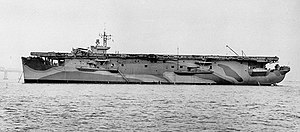 HMS Attacker
| |
| Class overview | |
|---|---|
| Name | Attacker class |
| Builders | |
| Operators | Royal Navy |
| Preceded by | Avenger class |
| Succeeded by | Ruler class |
| Built | 1941–1943 |
| In commission | 1942–1946 |
| Planned | 11 |
| Completed | 11 |
| Retired | 8 |
| Scrapped | 3 |
| General characteristics | |
| Type | Escort carrier |
| Displacement |
|
| Length | |
| Beam |
|
| Draught |
|
| Installed power |
|
| Propulsion |
|
| Speed | 18 kn (33 km/h; 21 mph) |
| Complement | 646 |
| Armament |
|
| Aircraft carried | 20 |
| Aviation facilities |
|
The Attacker class were a class of escort aircraft carriers in service with the British Royal Navy during the Second World War.
The United States Navy had acquired 22 C3 cargo ships shortly after the Attack on Pearl Harbor to be converted into the Bogue class. With an increasing need for convoy escorts in the North Atlantic eleven of these were transferred to the Royal Navy, and reclassified as Attacker class, under the terms of the Lend-Lease program.
The ships were originally intended to serve as convoy escort carriers, equipped with both anti-submarine and fighter aircraft, and transport carriers, transferring new and replacement aircraft to forward bases. During successful use during the amphibious invasion of North Africa to cover advancing ground units until land airbases were secured, several ships were refit as strike carriers, equipped with just fighter aircraft. When used as convoy escorts, the ships' aircraft were successful in deterring German submarines from attacking Allied convoys, with a number of German submarines and aircraft destroyed or damaged by the aircraft. Those carriers operating in the strike role took part in two major landings in the Mediterranean and an operation against the German battleship Tirpitz in Norwegian waters. Eight of the ships ended the war in the Far East in the campaigns against the Japanese Empire and were then used to transport home prisoners of war.
All eleven ships survived the war and were eventually returned to the United States Navy, which sold eight of them for conversion back into merchant ships. The other three ships were scrapped.